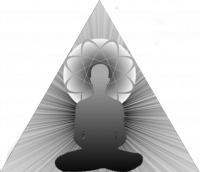
Scio-Buddhism
Faith and Philosophy Consistent with Reason and Reality
| Previous Page | Table of Contents | Next Page | 2:2 THE FOUR The Four All Compounded Things are ImpermanentTo understand the First It is hard to think or even conceive of a non-compounded and hence non-impermanent thing. Upon further reflection, however, it does seem that reality itself is not impermanent, since reality is an expanding eternal infinity; yet, reality does seem to be composed of all of the things which are contained within reality. Is it possible that reality is a compounded thing which is not impermanent? This is resolved by recognizing that as the constituent parts of reality eternally decay or combine into other things, this is essentially the same as reality eternally changing. A thing which is eternally changing cannot be said to be permanent. In fact, this insight can be used to update the Scionics view Mathematics, on the other hand, seems to be something which is truly non-compounded and non-impermanent. All of mathematics exists as an infinite, eternal, unitary whole. No part of mathematics can be removed from the rest. It exists as one, and can never not exist. Information presents an interesting case. Information (other than purely mathematical information) is compounded as it requires some form of substrate (such as matter or energy) for it to be stored, copied, represented, processed, and so on. While the substrate may be impermanent, however, the information itself may transcend this impermanence, at least potentially, precisely because it can be stored, copied, represented, processed, and so on, in some other substrate. Thus (non-purely-mathematical) information is both compounded and impermanent as a pattern in whatever substrate it may be represented, although it may be potentially permanent as a pattern in subsequent substrates; this potentiality is not an actuality, however. All Dualistic Experience Entails This seal seems to be the one which is translated in the greatest variety of ways, and of which there is also the greatest disagreement regarding the proper expression, although the expression above seems to be the most coherent form for Western readers. Some of the other translations commonly given are: All compounded things are (or entail) This list is by no means exhaustive. “ All Compounded Things Have no Inherent ExistenceThis is very closely related to the First While some compounded thing remains compounded, it may be useful to refer to it or to think of it as a unit. This usefulness, however, should not fool one into the false belief that it ultimately really is a unit. Instead one must always recognize that under the superficial unity of the thing lies any number of constituent parts, temporarily compounded together. When examining the First Dharma Seal, the special cases of reality, mathematics, and information were examined. These can be examined with reference to this Seal as well. When the compounded constituents of reality decay or combine into other things, these things which they decay or combine into remain a part of reality. Thus reality does have an inherent existence as a All of mathematics exists as an infinite, eternal, unitary whole. It exists as one, and can never not exist. Mathematics is a case of something being, in a sense, “compound” without being “compounded.” It has many parts, but no part of mathematics can be removed from the rest. Mathematics is non-compounded, non-impermanent, and like reality itself, has an inherent existence. Information (other than purely mathematical information) is compounded as it requires some form of substrate (such as matter or energy) for it to be stored, copied, represented, processed, and so on. Furthermore, any such substrate will always be compounded, and therefore not have an inherent existence of its own. Such substrate-dependent information is both compounded and has no inherent existence. Nirvana is Beyond ConceptsNirvana is typically translated as something like “liberation,” “freedom,” or “peace.” When put in such terms, nirvana does not seem to be “beyond concepts” at all, as these are easily understood and communicated concepts. Nirvana, however, actually refers to something beyond these words: to the freedom from dukkha which arises when all separating, dualistic, ego-based drives and demands are completely eliminated and replaced by the experience of profound unity between oneself and the world – but even these are fairly easily understood and communicated concepts. It is the experience of nirvana which is beyond concepts. This experience cannot be fully communicated to one who has not experienced it for oneself, just as one cannot fully explain the experience of “redness” to a blind person. To a blind person, certain things about “redness” may be comprehensible, such as the fact that it is distinguishable from other colors or that it is associated with certain wavelengths of light, but the experience of redness would be completely incomprehensible. In the same way, certain aspects of nirvana may be comprehensible, such as that is involves a form of freedom from suffering, for example, but the actual experience of nirvana, by its very nature, is incomprehensible to anyone who has not personally experienced it. | Previous Page | Table of Contents | Next Page | |
Please help advance Scio-Buddhism by commenting:
We welcome all comments, positive and negative, about our work and our website. We are particularly interested in any errors you find, whether these be simple typographical errors, or errors in facts or logic. If reporting an error, please be as specific as possible in identifying it, so that we will be able to properly identify and assess it. You may leave a publicly visible comment below, or in our forums, or you may send us a private comment using our contact page.
© 1988-2025 The Scionics Institute
© 2012-2025 The Church of Scio-Buddhism